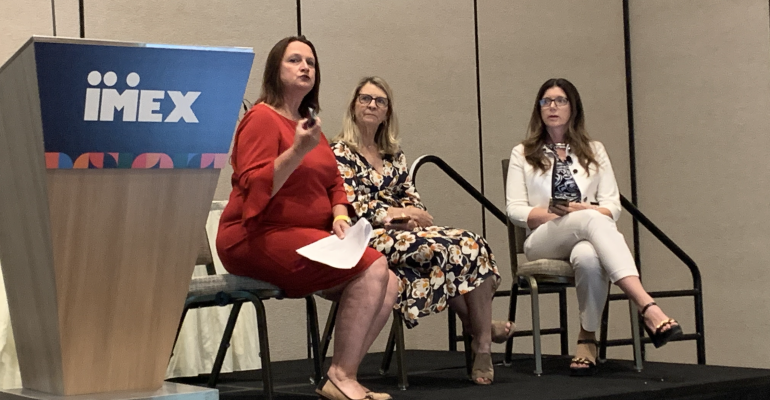While most of the breakout sessions during October’s IMEX America show in Las Vegas had detailed outlines for their educational content, one was rather different. Titled “Association Meeting Realities,” the session was mostly a group commiseration about a couple of entrenched problems with annual meetings that don’t seem to have clear solutions to satisfy all stakeholders.
Judging from the number of times the 75 or so planners in the room nodded their heads in agreement with the panel—and occasionally let slip a murmured “amen”—the session was much-needed catharsis.
Here are the two issues the planners kicked around.
In-Person vs. Virtual Considerations
Debbie Roepe, executive director of the International Society for the Study of Vulvovaginal Disease, said that “we are having a hard time predicting in-person attendance since the pandemic ended. It is tough convincing people that the in-person experience is much better for their education, especially when their bosses see what’s offered in our online version of the meeting and say, ‘Great, you don’t need to travel.’ We have to stress in all our marketing messages that the informal learning from colleagues on site is where you gain so much more benefit.”
Christina Gitsaki, director of the Center for Educational Innovation at Zayed University, U.A.E., and board member for the International Association of Applied Linguistics, added that “attendees in both mediums have higher expectations now. In the past two years, we have been trying to find the right amount of annual-meeting content to deliver virtually so that it delivers a good product but does not dissuade people from showing up in person. Also, how many sessions should we record on site, or do we present many of them again in a live format for the virtual audience?”
Roepe noted that the virtual annual meeting can be priced the same as in-person attendance if the offerings are robust, especially because “whatever money you save on food and beverage and other on-site elements has to be rolled into the technology for the virtual event.”
One thing she is convinced of regarding an annual meeting: “Doing it as a real-time hybrid is just not worth it, given the amount of labor you need and the time-zone considerations for attendees. I’ve heard too many stories about very low virtual attendance for real-time hybrids.”
Ksenija Polla, CMP, head of education and legacy programs for the International Congress and Convention Association, said that ahead of her organization’s 2024 annual meeting, “we are hosting online educational sessions throughout the year specifically to get more people to choose to attend in person. But not too many online sessions, and we are limiting the number of seats available” so that attendees are almost certain to have interaction with the virtual presenters if they choose.
Oh, One More Thing...
Polla brought up another issue that’s affecting in-person attendance in the post-pandemic environment: “‘Bleisure’ is a real thing, and associations have to appeal to it. You have to determine how far you’re willing to go to accommodate families at your annual event.” For instance, would it benefit an association to provide day care at the host hotel or at the convention center? Should meals, receptions, and social events allow for family participation? And can the planning team secure favorable hotel-room rates for two or even three days on either side of the event’s schedule so that attendees use the annual meeting as the impetus for a family vacation?





